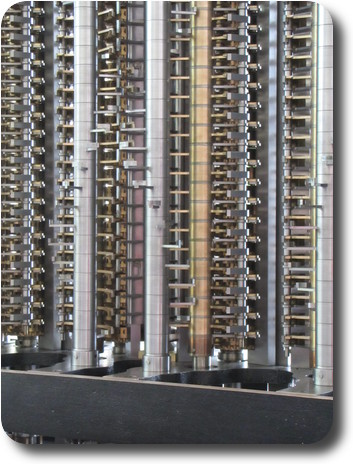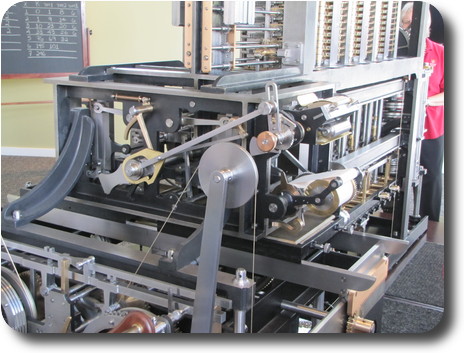
Charles Babbage (1791 - 1871) wanted to bring "the power of steam" to correctly calculate and print the tables then used by occupations as varied as bankers, sailors and engineers. The many printed tables then in existence had numerous errors and inconsistencies, which could perhaps lead to financial ruining, sailing onto rocks or a bridge failing. Thus, the need was very important. Much detail of the life or Babbage, and his attempts at building mechanical calculating engines are available from the Computer Museum's web site. And there's also a video clip of the engine in action - it's well worth a look.
The machine weighs five tons, has 8000 parts (half in the printer!) and is 11 feet long. The printer is located at the left hand end, and there is a crank handle on the right hand end to activate the mechanism.
 Not a huge crowd watching, but there was great interest among them.
Well, not so much the children...
Not a huge crowd watching, but there was great interest among them.
Well, not so much the children...
 The is the front of the machine, showing the number wheels which are
used to set values into the machine before a calculation is done,
and which are used to read the number when finished (in addition to
the number being printed).
The is the front of the machine, showing the number wheels which are
used to set values into the machine before a calculation is done,
and which are used to read the number when finished (in addition to
the number being printed).
 This is the rear of the machine, and basically is used to handle
the "carry bit" - the need to add one to the next most significant
column of numbers when a column's value goes from 9 to 0. The
helical arrangement is quite clever, as it allows the carry to
propagate along a string of digits. Think of adding 1 to 29999.
One the first part of the operation, the number goes to 29990 with carry.
The carry is applied to the next digit, creating 29900 with carry.
Which then applies to the next digit, 29000 with carry. And so
20000 with carry turns into 30000! By staggering the determination
of the carry bit, the helical structure ensures correct addition.
Although operating at much higher speeds, this same issue happens
in electronic computers, though there are clever ways to speed it up.
This is the rear of the machine, and basically is used to handle
the "carry bit" - the need to add one to the next most significant
column of numbers when a column's value goes from 9 to 0. The
helical arrangement is quite clever, as it allows the carry to
propagate along a string of digits. Think of adding 1 to 29999.
One the first part of the operation, the number goes to 29990 with carry.
The carry is applied to the next digit, creating 29900 with carry.
Which then applies to the next digit, 29000 with carry. And so
20000 with carry turns into 30000! By staggering the determination
of the carry bit, the helical structure ensures correct addition.
Although operating at much higher speeds, this same issue happens
in electronic computers, though there are clever ways to speed it up.
 This is the timing and control part of the engine. The crank handle's
motion operates the various cams along the vertical column, and
these in turn operate the mechanism causing the additions to
be performed within the machine, and the printing of the results.
This is the timing and control part of the engine. The crank handle's
motion operates the various cams along the vertical column, and
these in turn operate the mechanism causing the additions to
be performed within the machine, and the printing of the results.
 The printer end of the machine. Despite the time of its invention,
it was programmable, and could print up to 3 columns of numbers,
with varying degrees of precision.
The printer end of the machine. Despite the time of its invention,
it was programmable, and could print up to 3 columns of numbers,
with varying degrees of precision.
 A closer view of the printer mechanism, sitting alongside the final
column of numbers, which are the result column.
A closer view of the printer mechanism, sitting alongside the final
column of numbers, which are the result column.
 The actual printing part. In addition to printing on paper, it
could print onto a stereotype (effectively making it a mould) from
which printing plates could be made, and thus Babbage's real
objective - printing of correct tables - would be accomplished.
The printed paper was to allow visual check as the calculations
progressed.
The actual printing part. In addition to printing on paper, it
could print onto a stereotype (effectively making it a mould) from
which printing plates could be made, and thus Babbage's real
objective - printing of correct tables - would be accomplished.
The printed paper was to allow visual check as the calculations
progressed.
 The tools of the mechanical computer technician! Rather different,
and much less expensive, than modern day computer tools, though
the non-repairable style of modern PC components perhaps reverses
that trend.
The tools of the mechanical computer technician! Rather different,
and much less expensive, than modern day computer tools, though
the non-repairable style of modern PC components perhaps reverses
that trend.
 This is used to explain how the difference engine performs its
calculations. While I could go on and explain how this happens,
the Museum's web site has a
worked example,
complete with an explanation of how to set the machine up. It does
require some initial manual calculations, but once the values are
determined, off it goes.
This is used to explain how the difference engine performs its
calculations. While I could go on and explain how this happens,
the Museum's web site has a
worked example,
complete with an explanation of how to set the machine up. It does
require some initial manual calculations, but once the values are
determined, off it goes.
 The two people who ran the machine and explained its operation
as they went. On the left,
Wolfgant Schacchter
and
Julie Neff
on the right. They received quite a round of applause at the end
of the demonstration, and were quite happy to answer any questions,
even really odd or obscure ones!
The two people who ran the machine and explained its operation
as they went. On the left,
Wolfgant Schacchter
and
Julie Neff
on the right. They received quite a round of applause at the end
of the demonstration, and were quite happy to answer any questions,
even really odd or obscure ones!
All in all, this was a most excellent museum, well deserving of another visit. But if you want to see the Babbage Engine, do so before the end of the year, when Nathan Myrhvold takes it into his personal collection.
![]() Computer History Museum I
Computer History Museum I
![]() Heading to Yosemite
Heading to Yosemite
![]() Reunions
Reunions